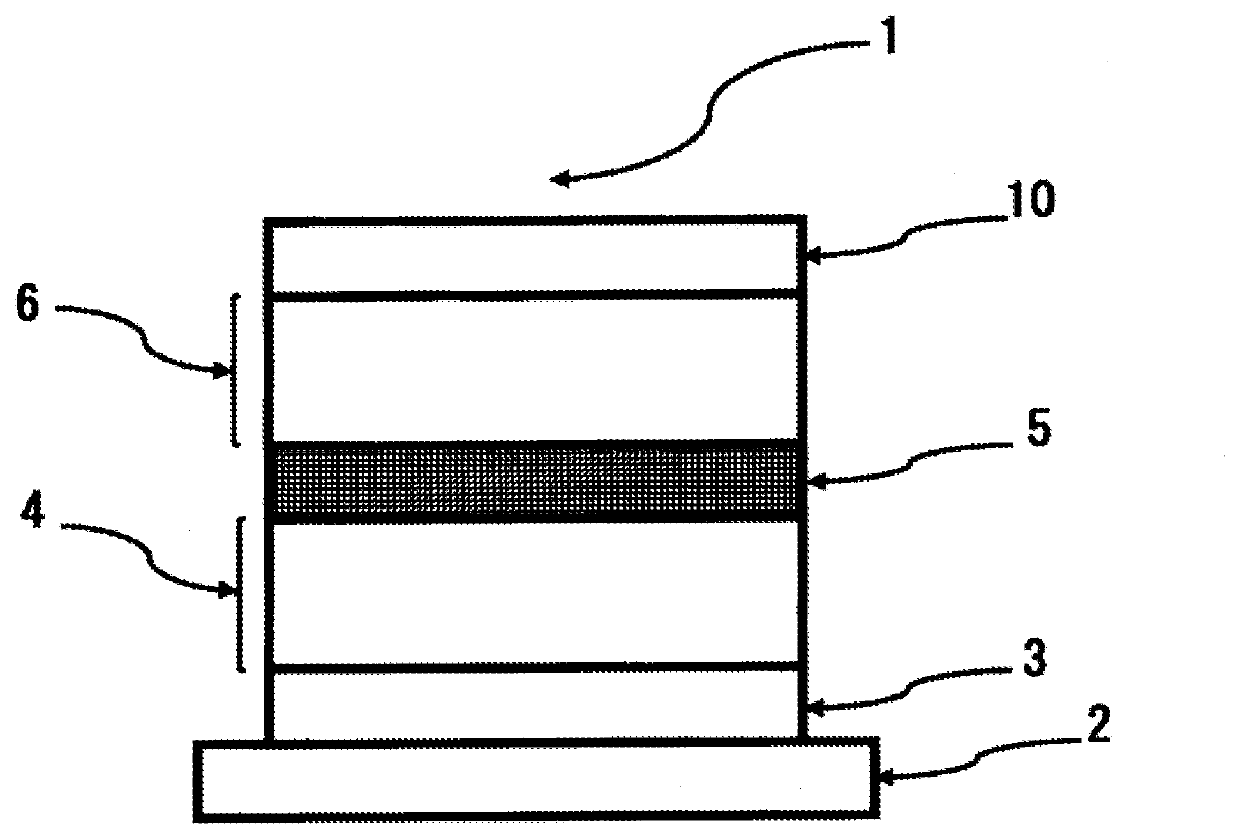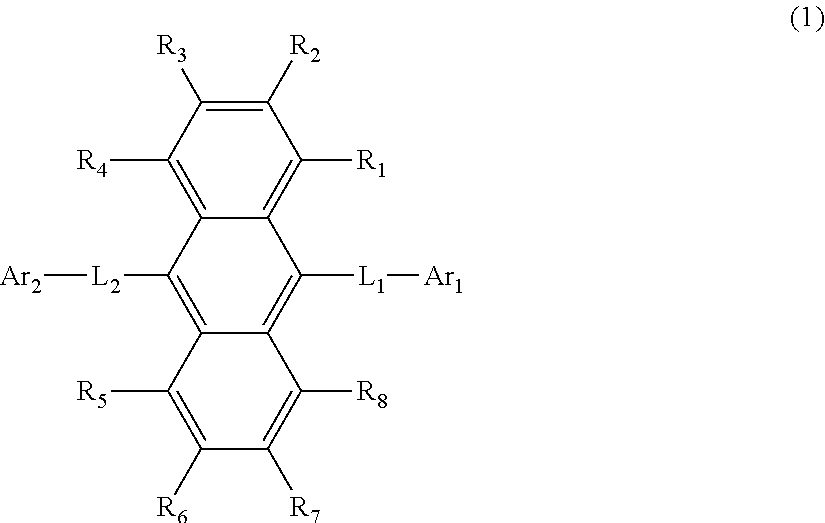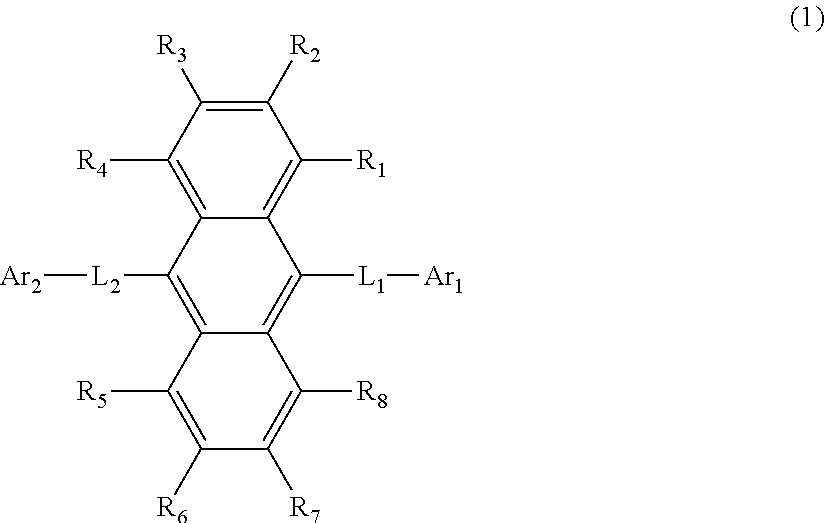Organic electroluminescence device and electronic apparatus provided with the same
a technology of electroluminescence device and electronic apparatus, which is applied in the direction of luminescent composition, chemistry apparatus and processes, organic chemistry, etc., can solve the problem of difficulty in obtaining an organic el device which satisfies both the properties
- Summary
- Abstract
- Description
- Claims
- Application Information
AI Technical Summary
Benefits of technology
Problems solved by technology
Method used
Image
Examples
synthesis example 1 (
Synthesis of BH-1)
[0646]Synthesis scheme of BH-1 is shown below. Hereinafter, TfO represents trifluoromethanesulfonate.
(1-1) Synthesis of BH-1-1
[0647]Under an argon atmosphere, a mixture of 40.0 g of anthracene d-10, 38.0 g of NBS (N-bromosuccinimide), and 1200 mL of dimethyl formamide (DMF) was stirred at room temperature for 16 hours. The resultant reaction liquid was cooled to room temperature, followed by filtration. Then, the solvent of the obtained filtrate was distilled off under reduced pressure. The obtained residue was purified by column chromatography to give 42.0 g of BH-1-1 in an yield of 75%.
(1-2) Synthesis of BH-1-2
[0648]Under an argon atmosphere, a mixture of 42.0 g of BH-1-1, 30.0 g of 1-naphthaleneboronic acid, 3.70 g of tetrakistriphenylphosphine palladium, 160 mL of a 2M sodium carbonate aqueous solution, and 750 mL of dimethoxyethane (DME) was stirred at 80° C. for 8 hours. The resultant reaction liquid was cooled to room temperature, and extracted with ethyl ac...
synthesis example 2 (
Synthesis of BH-2)
[0653]Synthesis scheme of BH-2 is shown below.
(2-1) Synthesis of BH-2
[0654]Under an argon atmosphere, a mixture of 4.0 g of BH-1-4, 3.5 g of BH-2-1, 0.260 g of tetrakistriphenylphosphine palladium, 10 mL of a 2M sodium carbonate aqueous solution, and 70 mL of DME was stirred at 80° C. for 8 hours. The resultant reaction liquid was cooled to room temperature, and extracted with ethyl acetate. Then, the organic phase was washed with water, dried over anhydrous magnesium sulfate, followed by distillation of the solvent under reduced pressure. The obtained residue was purified by silica gel column chromatography and recycllization to give 2.9 g of BH-2 in an yield of 59%. The compound was identified by molecular weight determination with FD / MS. It was confirmed that m / e=438 for the molecular weight of 438.
synthesis example 3 (
Synthesis of BH-3)
[0655]Synthesis scheme of BH-3 is shown below.
(3-1) Synthesis of BH-3
[0656]Under an argon atmosphere, a mixture of 4.0 g of BH-1-4, 4.5 g of BH-3-1, 0.260 g of tetrakistriphenylphospine palladium, 10 mL of a 2M sodium carbonate aqueous solution, and 70 mL of DME was stirred at 80° C. for 8 hours. The resultant reaction liqid was cooled to room temperature, and extracted with ethyl acetate. Then, the organic phase was washed with water, dried over anhydrous magnesium sulfate, followed by distillation of the solvent under reduced pressure. The obtained residue was purified by silica gel column chromatograpy and recrystallization to give 3.2 g of BH-3 in an yield of 55%. The compound was identified by molecular weight determination with FD / MS. It was confirmed that m / e=514 for the molecular weight of 514.
PUM
| Property | Measurement | Unit |
|---|---|---|
| work function | aaaaa | aaaaa |
| work function | aaaaa | aaaaa |
| thickness | aaaaa | aaaaa |
Abstract
Description
Claims
Application Information
 Login to View More
Login to View More - R&D
- Intellectual Property
- Life Sciences
- Materials
- Tech Scout
- Unparalleled Data Quality
- Higher Quality Content
- 60% Fewer Hallucinations
Browse by: Latest US Patents, China's latest patents, Technical Efficacy Thesaurus, Application Domain, Technology Topic, Popular Technical Reports.
© 2025 PatSnap. All rights reserved.Legal|Privacy policy|Modern Slavery Act Transparency Statement|Sitemap|About US| Contact US: help@patsnap.com



